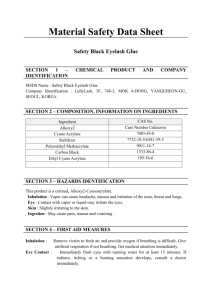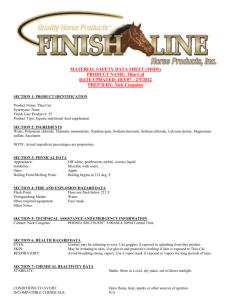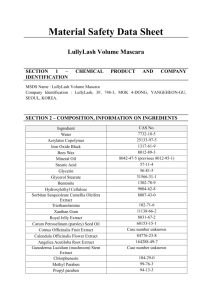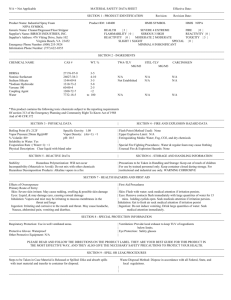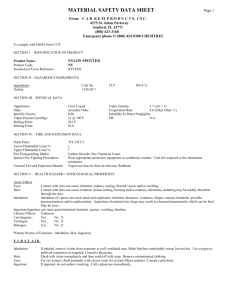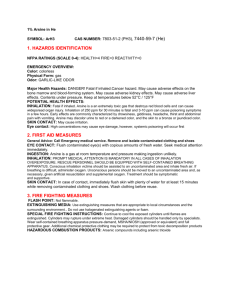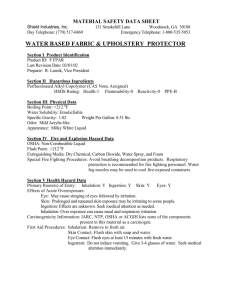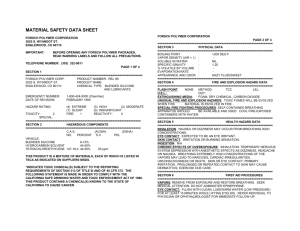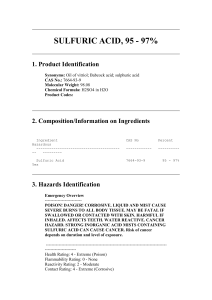Date Prepared: 12/29/10 Material Safety Data Sheet Section 1
advertisement
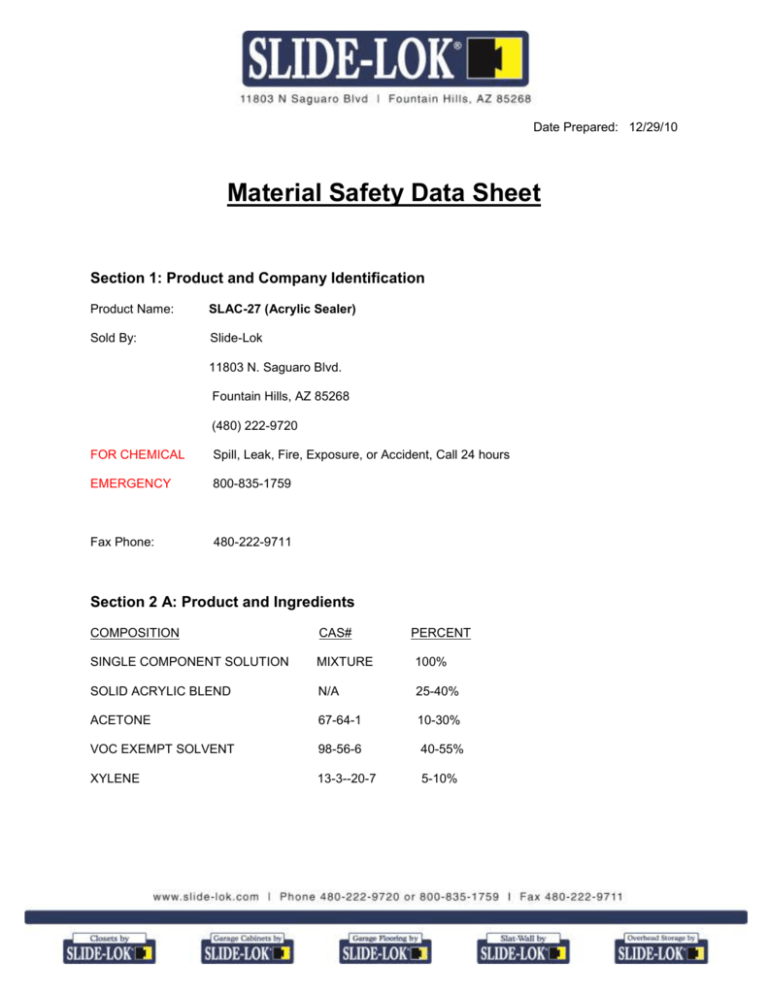
Date Prepared: 12/29/10 Material Safety Data Sheet Section 1: Product and Company Identification Product Name: SLAC-27 (Acrylic Sealer) Sold By: Slide-Lok 11803 N. Saguaro Blvd. Fountain Hills, AZ 85268 (480) 222-9720 FOR CHEMICAL Spill, Leak, Fire, Exposure, or Accident, Call 24 hours EMERGENCY 800-835-1759 Fax Phone: 480-222-9711 Section 2 A: Product and Ingredients COMPOSITION CAS# PERCENT SINGLE COMPONENT SOLUTION MIXTURE 100% SOLID ACRYLIC BLEND N/A 25-40% ACETONE 67-64-1 10-30% VOC EXEMPT SOLVENT 98-56-6 40-55% XYLENE 13-3--20-7 5-10% Section 2 B: Toxicity Data Number Acute Oral LD50 P No Data 1 ACRYLIC N/A 2 ACETONE 9.75 G/Kg (RAT) 3 VOC EXEMPT SOLV. N/A 4 XYLENE 9.00 G/Kg (RAT) Acute Dermal LD50 Acute Inhalation No Data No Data N/A NON-TOXIC 20.0 G/Kg (RABBIT) N/A 18.0 G/Kg (RABBIT) 16,000ppm/4H (RAT) N/A 14,000PPM/4H (RAT) Section 3 A: Health Information Eye Contact MAY CAUSE IRRITATION. WE RECOMMEND YOU WEAR GOGGLES AND/OR FACE SHIELD. HAVE EYE WASH UNIT AVAILABLE. Skin Contact MAY CAUSE SKIN IRRITATION. AVOID CONTACT. WEAR PROTECETIVE CLOTHING AND GLOVES. Inhalation EXTENDED EXPOSURE TO FUMES MAY CAUSE IRRITATION TO RESPIRATORY SYSTEM, POSSIBLY CUASING A VARIETY OF SYMPTOMS INCLUDING DIZZINESS, DRYNESS OF THROAT, HEADACHES AND GENERAL CONFUSION. Ingestion HARMFUL IF SWALLOWED. DO NOT INDUCE VOMITING. CONTACT PHYSICIAN IMMEDIATELY. Signs / Symptoms IRRITATION AS NOTED ABOVE. LUNG DAMAGE (SCARRING, BRONCHITIS, EMPHYSEMA) MAY BE EVIDENCED BY SHORTNESS OF BREATH, ESPECIALLY ON EXERTION, AND MAY BE ACCOMPANIED BY CHRONIC COUGH. SKIN SENSITIZATION (ALLERGY) MAY BE EVIDENCED BY RASHES, ESPECIALLY HIVES. Section 3 B: Hazards Identification Emergency Overview: Routes of Entry: Route Entry Risk Inhalation Possible Ingestion Possible Skin Contact Possible Eye Contact Possible Potential Health Effects: Inhalation - Vapors/Mists may be corrosive to upper respiratory tract. Repeated exposure may result in lung damage. May be toxic if inhaled. Ingestion - Not expected to be a relevant route of exposure, however, corrosive and may cause severe and permanent damage to mouth, throat, and stomach. Skin Contact - Corrosive to the skin. May cause skin sensitization. Eye Contact - Corrosive to the eyes and may cause severe damage including blindness. Vapors may be irritating. Acute Health Hazards: No information is available on the acute health hazards of this product. Based upon data from testing of similar products, no significant effects are expected. Chronic Health Hazards: Eye contact may result in blindness. Inhalation may result in lung damage. Ingestion may cause permanent damage to mouth, throat, and stomach. Carcinogenicity: OSHO: No Data ACGIH: No Data NTP: No Data IARC: No Data Section 4: First Aid Measures Eye Contact: Immediately flush eyes with plenty of water for at least 15 minutes while holding eyelids open. Rinse continuously with water while on way to get medical attention. Skin contact: Immediately remove contaminated clothing or shoes, wipe excess from skin and flush with plenty of water for at least 15 minutes. Use soap if readily available, or follow by thoroughly washing with soap and water. Do not reuse clothing until thoroughly decontaminated. Ingestion: Do not induce vomiting. Give one glass of water unless victim is drowsy, convulsing, or unconscious. Seek medical attention immediately. Inhalation: Remove victim to fresh air and provide oxygen if breathing is difficult. Get medical attention if necessary. Section 5: Fire-Fighting Measures Flammable Limits: -% volume in air Flash Point and Method: T.C.C., F. 0 Deg F, based on Acetone content Auto ignition Temperature: N/A Extinguishing Media: USE WATER FOR, "ALCOHOL" FOAM, DRY CHEMICAL OR CO2 Special Fire Fighting The acetone content of formula is quite flammable, however as a blend, the Procedures: flammability is somewhat reduced. Clear fire area of unprotected personnel. Do not enter confined fire space without full bunker gear, including a positive pressure NIOSH approved self contained breathing apparatus. Unusual Fire and Explosion Hazards: Keep away from open flames and high temperatures. If present in the area the product will be used, we recommend you turn off any pilot lights until product is dried and fumes have dissipated. Section 6: Accidental Release Measures Accidental Release Measures: Avoid contact with material. Persons not wearing appropriate protective equipment should be excluded until spill is cleaned up. Stop spill at source, pump liquid to a salvage container. Use Cautious judgment when cleaning up large spills. CAUTION: May burn although not readily ignitable. Section 7: Handling and Storage Handling & Storage Precautions: Prevent all skin and eye contact. Avoid breathing vapors. Store in a cool, dry place with adequate ventilation. Keep away from open flames and high temperatures. Containers, even those that have been emptied, can contain hazardous product residues. Wash with soap and water before eating, drinking, smoking, applying cosmetics, or using toilet facilities. Section 8: Exposure Control/Personal Protection Ventilation: Adequate ventilation required. Local exhaust may be required in some areas. Special exhausting generally not required. Mechanical exhaust usually adequate. Respiratory Protection: Do not breathe vapors or mists. If exposure may or does exceed occupational exposure limits use a NIOSH approved respirator to prevent overexposure. Avoid breathing vapors which may be produced under some conditions such as heating or applications or uncured material in large surface areas. Avoid breathing aerosols and mists which may be formed by various methods of application. Eye Protection: Chemical tight goggles; full face shield if splashing is possible. Skin Protection: Avoid all Skin contact. Other Protective Clothing: Do not get in eyes. Wear chemical goggles if there is potential contact with eyes. Do not get on skin, on clothing. Wear chemical resistant protective clothing such as gloves, outer clothing or apron, overshoes and a face-shield suitable to potential exposure. Work/Hygienic Practices: Good air flow in working area. Eyewash station and safety shower should be available. Gloves and respiratory equipment should be worn at all times. Section 9: Physical and chemical Properties Appearance: Mobile Liquid with solvent odor Physical State: Liquid ph As Supplied: Not applicable Boiling Point: Over 200 Degrees F. Melting Point: N/A Pout Point: N/A Vapor Pressure(mmHg): Not determined Specific Gravity(Water): Heavier than H20 Volatile Organic Compounds(VOC): Not determined Solubility In Water: Negligible Percent Volatile: N/A Section 10: Stability and Reactivity Stability: STABLE Hazardous Polymerization: WILL NOT OCCUR Conditions and Materials to Avoid Avoid heat, flame and contact with strong oxidizing agents. Hazardous Decomposition Products Nitrogen Oxides, Carbon Monoxide and Unidentified organic compounds may be formed during combustion. Section 11: Employee Protection Respiratory Protection Do not breath vapors or mists. If exposure may or does exceed occupational exposure limits use a NIOSH approved respirator to prevent overexposure. Avoid breathing vapors which may be produced under some conditions such as heating or applications or uncured material in large surface areas. Avoid breathing aerosols and mists which may be formed by various methods of application. Protective Clothing Do not get in eyes. Wear chemical goggles if there is potential contact with eyes. Do not get on skin, on clothing. Wear chemical resistant protective clothing such as gloves, outer clothing or apron, overshoes and a face shield suitable to potential exposure. Additional Protective Measures Use ventilation as required to control vapor concentrations. Eye wash fountains and safety showers should be available for emergency use. Section 12: Environmental Protection Spill or Leak Procedures Keep ignition sources out of area and shut off all ignition sources. Handling equipment must be grounded to prevent sparking. Absorb spill with inert material (Dry sand or earth) then place in a chemical waste container. Flush area with water to remove trace residue. Section 13: Special Precautions Store in a cool, dry place with adequate ventilation. Keep away from open flames and high temperatures. Containers, even those that have been emptied, can contain hazardous product residues. Wash with soap and water before eating, drinking, smoking, applying cosmetics, or using toilet facilites. Section 14: Transportation Requirements Department of Transportation Classification: CLASS 3 (FLAMMABLE MATERIAL), III D.O.T. PROPER SHIPPING NAME PETROLEUM DISTILLATES, N.O.S., (Naphtha Solvent) Marine Pollutant
